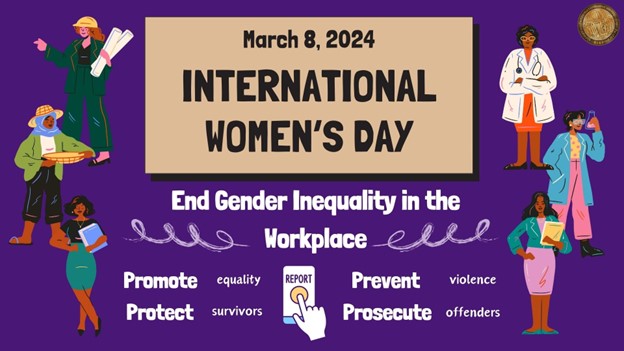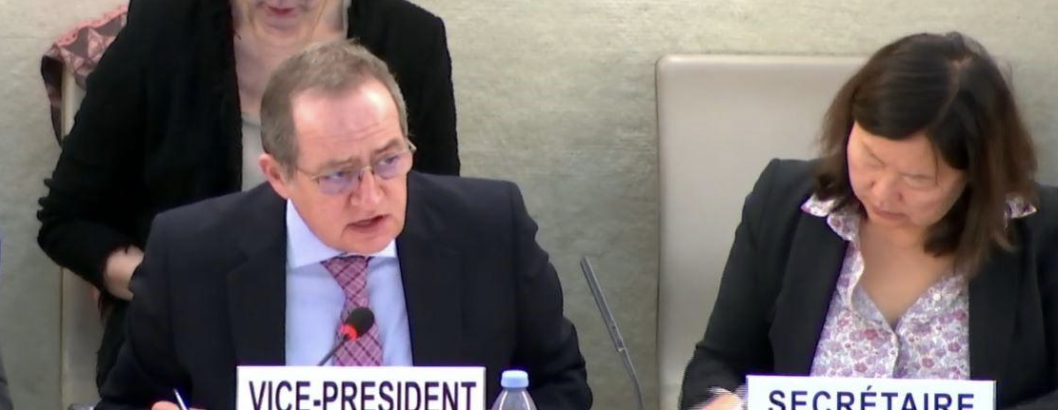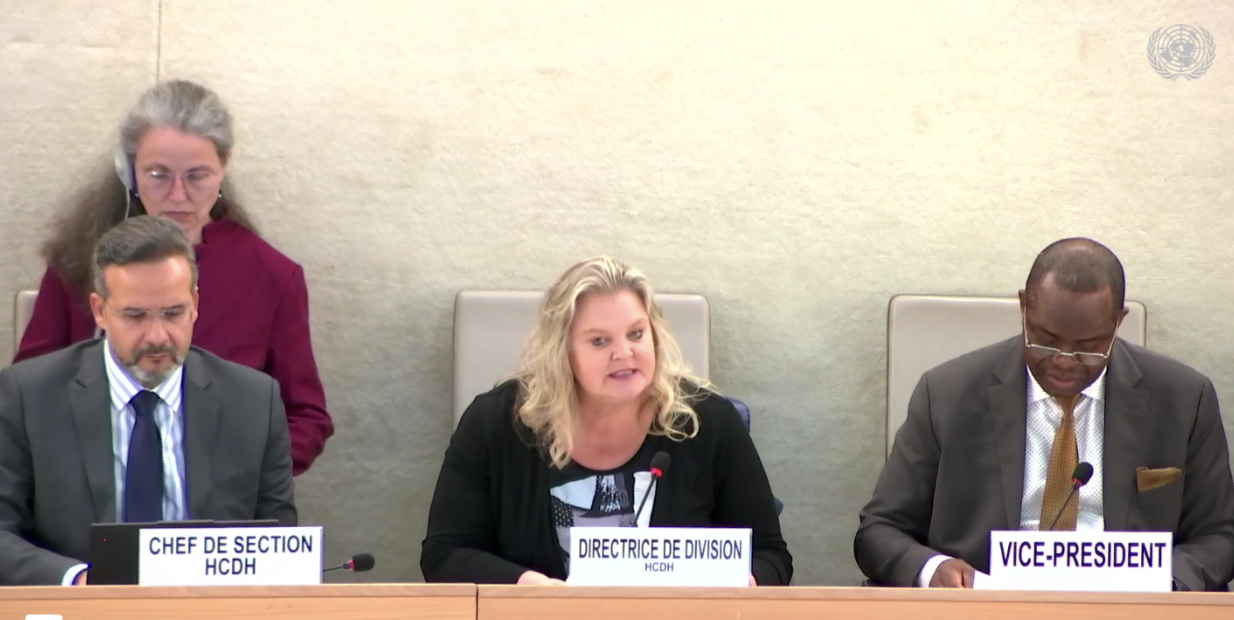Ending gender inequality in the workplace — investing in due diligence: the 4Ps to end sexual harassment in the workplace: promote, prevent, protect, investigate and prosecute.

By Julia Rowland / GICJ
The history of international women’s day: an ongoing struggle for equality
International Women’s Day (IWD) is celebrated globally each year on March 8th. It focuses on many issues including gender equality, reproductive rights and gender-based violence against women (GBVAW). Originating in the early 20th century and spurred on by the universal female suffrage movement, IWD’s foundations can be traced back to socialist and communist movements in the United States of America and Russia.
The first wave of demonstrations occurred on March 19th 1911, where over a million people in Austria, Denmark, German and Switzerland marched demanding for the right to vote, for the right to hold public office, and to protest sex discrimination in the workplace. A few years later, in 1914, IWD was held on March 8th in Germany and England for the first time with women protesting for universal suffrage which was eventually granted in 1918 in both countries. Protests on IWD in Czarist Russia engulfed Petrograd on March 8th, 1917, demanding for the end of World War I, food shortages and czarism. It was these protests that inaugurated the Communist revolution, bringing with it the abdication of Tsar Nicholas II just a week later. The provisional government that was set up in the wake of the abdication granted women the right to vote.
Since then, IWD has expanded beyond being primarily commemorated in communist and socialist countries and is widely celebrated all over the world. In 1975, the United Nations began celebrating IWD, launching in the same year the UN Decade for Women (1975-1985) which saw the creation of several foundational documents and plans regarding the human rights of women. One of the achievements that arose from this decade, was the creation of the UN Convention on the Elimination of Discrimination Against Women (CEDAW), in 1979. It formally established a legal regime for the human rights of women, bringing about a new era focusing on transformative equality. At CEDAW’s core is the objective of transformative change, that is, altering the mindsets, prejudices and stereotypes that underpin patriarchy and systemic gender discrimination.
Gender-based discrimination and violence against women: a persistent and entrenched problem in all spheres
While progress has been made, the UN Sustainable Development Goal (SDG) tracker for Goal 5 (gender equality), predicts that at the current rate, it will take close to 300 years to close gaps in legal protection, to remove discriminatory laws, and to end child marriage. It will take 140 years to achieve equal representation in leadership in the workplace. Globally, 1 in 3 women and girls have still experience intimate partner violence, non-partner sexual violence or both. These staggering statistics are unfortunately the consequences of chronic underinvestment and active resistance to the cause of gender equality. According to UN Women, the underinvestment can be quantified at a staggering USD 360 billion annual deficit in spending on gender-equality measures.
Investing in mechanisms that support measures to bring the end of GBV and discrimination is therefore paramount, as is the inclusion of men in boys in changing discriminatory mentalities and stereotypes. The current international human rights regime has created a framework based around the concepts of the 4 Ps: promote, prevent, protect and prosecute. In other words: to promote the empowerment of women, to prevent discrimination, to protect in cases of discrimination, and to investigate and prosecute those who discriminate. This applies to all forms of discrimination which include: psychological, verbal, physical, sexual and economic discrimination and violence. Discrimination can happen in any sphere, from the most private places such as the home, to places of work, or out in public.
States must implement effective policies covering all 4 Ps and incorporate these at the legislative, executive and judicial levels of government, and ensure Non-State Actors do the same. This also means that States must unlock financing from diverse sectors and adjust national budgets in line with gender-responsive budgeting. This would allocate more resources to prevent discrimination against women before it can even begin.
Focus: gender inequality in the workplace
The private sector plays a critical role in advocating for, and adopting prevention measures to create safe working environments, particularly for women and girls who are at elevated risk. More than 1 in 5 people experience violence in the form of physical, psychological or sexual harassment in the workplace. On average 8% of women, compared to 5% of men, experience harassment or violence at work, with young women being twice as likely to experience it as young men.
The International Labour Organisation (ILO) released this statement on the topic:
“Sexual harassment is overwhelmingly a problem of women workers. It has nothing to do with normal interaction between the sexes: it denotes scorn of another person, and is used to establish or prove power over others. Sexual harassment produces feelings of revulsion, violation, disgust, anger and powerlessness. Good managers know that it is in the long-term interest of the enterprise to ensure that their employees are treated with respect. While effective legal remedies are necessary, it is also important to ensure that the problem ceases, or better still, never starts. Thus, preventive measures are especially important.”[1]
Sexual harassment in the workplace can occur in several, not mutually exclusive forms, including:
- Verbal harassment: making suggestive comments about the appearance of members of staff; making sexist remarks or jokes about sexual characteristics or sexual orientation of members of staff.
- Digital harassment: displaying, posting, or distributing pornographic material in the workplace; unwanted phone calls, emails, letters, text messages or short messages with sexist or suggestive content; sending members of staff unsolicited invitations with obvious intent.
- Physical harassment: any unwanted form of physical contact or sexual advances including petting, groping or kissing; following employees inside or outside the company; attempting to get close to an employee in a way that involves promises of advantage or threat of disadvantage; requests for sexual favours; feeling pressure to engage with someone sexually; exposing oneself or performing sexual acts on oneself; sexual assault or rape.
Geneva International Centre for Justice (GICJ) condemns all forms of gender-based violence against women. Cultivating a safe and respectful environment for all in the workplace is paramount to ensuring gender equality across the board. Gender-based violence against women is a global issue that transcends geographical and cultural bounds. We celebrate the women all over the world who have worked tirelessly to promote equality, and urge governments to uplift women’s voices and work towards achieving full equality.
_________
[1] https://gbv.itcilo.org/index.php/briefing/show_paragraph/id/63.html







